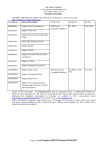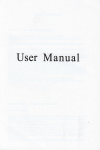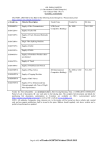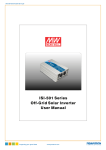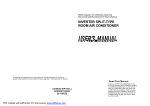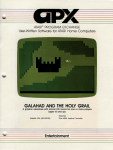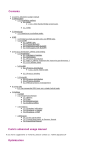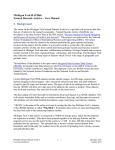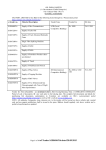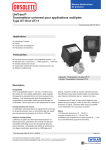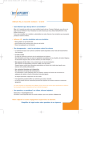Download A Date with KIM, May 1976, BYTE Magazine
Transcript
Photo 1,' When you first open your KIM-l box, you see a thick layer of documentation, including a large 'vWI/ chart of the sys tem's hard'vWre details, an MCS650X Instruction Set SummaJY card, KIM -1 User Manual, Progra mming Hard ware Ma nual and Manu al. Also sho wn in this picture is the KIM m onitor listing copy which must be requested separately and is a must if you are to take advantage of KIM 's subroutines in applications programs. A Date with KIM Richard S Simpson 314 Second Av Haddon Heights NJ 08035 Here it is! In the November '1975 BYT E, Dan Fylstra revi ewed th e ca pab iliti es o f the MOS Technol ogy 6501 mi croprocesso r chip in an article titled "Son of Motorola" (p age 56) . The article stated that "it will be three to six mo nth s before yo u see (a 65 0'1) designed into a kit., ." We ll , MOS Technology has gone o ne better an d introduced not a kit, but a co mpl etely asse mbl ed, tes ted and warranteed mi croco mputer with a pri ce tag of o nly $250 1 Using t he 6502 processo r chip (a 6501 with an o n-chip cl ock ), th e microco mputer features 1 K o f RAM, 2 K of ROM co ntaining t he system executive, a co mpl ete audi o casse tte interface , a se ri al terminal interface,15 bidirect ional 10 lin es, a 23 key keypad and a si x digit LED di spl ay. Thi s co mpl etely asse mbl ed one board co mputer has all th e programming fea tures of the 6502 a t a very co mpetitive pri ce. If you have bee n hes itating over buyin g a mi croco mputer beca use o f the diffic ul ty of asse mbly and the fea r tha t it wo n't work wh en yo u're fini shed, KIM- 'I is for yo u. Th e only assembl y required is to attac h six se lf adhesive pl asti c feet to th e back of the 8 KIM -1 printed circuit boa rd and attach a +5 volt , 1 ampere power supply to th e 44 pin edge connecto r pr ovided . Yo u'll also nee d a supply of +'12 V for th e casse tte interface ; but a handful o f flashlight batte ri es sho uld work fin e since only abo ut 50 mA of +'12 V is required, and tha t o nl y wh en th e interface is being used. Th e name KIM is an acro ny m for Keyboa rd Input Mo nito r. Th e na me reall y describes th e ROM exe cutive routin es, no t th e wh ole unit, bu t it 's a pl easant change fr o m the manufactu re r's name foll o wed by a number. It' s also signi fica nt that th e sys tem derives its name fro m its software. Th e KIM-l board can be opera ted in one of two modes: using th e on boa rd keypad and LED di spl ay , o r using a serial terminal. Th e key pad and hexadec imal displ ay is infini te ly eas ier and les s error pro ne th an throwing toggle sw itches and reading results fr o m bin ary lamps. In fact, for program entry and many simpl e appli ca ti ons, I prefer the 23 key key pad and bri ght LED di spl ay to my slow, noisy Te letype, Th e keys have a good, pos it ive "fee l" to them (MO S Tec h- Photo 2: The KIM-l processor as it is removed from its box. Th e MOS Technology produ c t comes in a neat package which has one foam padded and static protected KIM-l board as its bottom layer. nology should know about such things, since they a re a major manufacturer of chips for calculators). The switch in the upper right corner of the keypad puts the machine in single instruction (not single cycle) mode . When the switch is "on, " each depression of the "GO" button causes a single instruction of your program to be executed. Control is then returned to the executive program in ROM and the contents of a ll six machine registers (PC, X, Y, S, P, and the accumulator) are stored in fixed memory location s where you can easi ly examine them through th e keypad or terminal and then "GO" to the ne xt instruction . This is a n important capability, since if you just halt a microprocessor after each instruction there is no way of examining the registers (they're all inside the chip!). I won't go into any detail on the instruction set (see Dan Fylstra's article for that) except to say that it is comprehensive. The variety of addressing modes makes complex progra mming (especially when processing lists) a lot easier. The 6502 architecture has no 10 register or 10 instructions, so any memory location can become an 10 "port" if you build the hardware for it. KIM comes with a built-in 15 line bidirectional 10 interface. TTL levels are acce ptable, of course, and one of the lines can supply enough current (5 mAl to directly drive a power transistor. The manu al shows how to use it to drive a small speaker for "microprocessor music" programmed in a manner similar to the Kluge Har p of October BYTE (page 14). Each line can be separately programmed for input or output by writing a status word into the correct memory location. The cassette interface is carefully thought o ut and should be foolproof. Half of the executive ROM is devoted to the cassette interface software, which includes rudimentary file manage ment an d sophisticated programmed eq uivalents to UART operation. This software allows mUltiple dumps to a singic cassette. A header written on each o utput segment allows you to say, in effect, "find me program number 34 on the ta pe and load it starting at location ... " A checksum is stored at the end of each segment a nd the user is immediate ly informed if the computed checksum doesn't match when the tape is read back in. You can even record voice data between segments of digital data - the inte rface will ignore the voice. This feature could be used to verbally record the instructions for a game and then automat ically load and run it. Both high and low leve l outputs are provided to interface with any type of cassette recorder. It's not a vital feature, but it indicates the care with which the entire system has been thought out. The TTY interface is for a standard 20 mA curr.ent loop (figure 1 shows how I modified it fo r an RS-232 interface ). A unique feature of the softwa re is automatic data rate detection. As soon as the system is powered up, the user types a RUBOUT character on his termi nal . The software 9 If you have been hesitating over buying a microcomputer because of the difficulty of assembly and the fear that it won't work when you're finished, then KIM-1 is for you. KIM-1 derives its name from the software, a significant indication of the importance of good user support programs. 2 0 mA CURRENT LOOP TO RS- 2 3 2 CON VERSI ON RS- 232 CONNE CTO R K IM - I APP LI CA TION CON NE CTOR 4N 33 1.3K 2 2 S PC artwo rk, and th e fa ct t hat the board is coa ted with a so lder mask, a plasti c coat ing which pro tects the prin ted wiring. To fur ther e mphas ize their fa ith in KIM, MOS Tec hnology gives yo u a 90 day warranty on the ent ire KIM syst em, not just the co mpo nents. Mail- in re pair se rvice is ava ilabl e even after the warranty ex pires. DATA Interval Timer T 4 2K +5 A 4N33 3 - - DATA R -+--0 u '---;..::. 2____ Figure 7: One way to interface KIM- 7 with an RS-232 compatible terminal is illustrated in this diagram. Opto isolators are used to accomplish the coupling. The RS-232 pins 7, 2 and 3 will be su fficient for terminals which do not in volve handshaking,. on some terminals, pins 5, 6, 8 and 20 o f the standard RS-232 plug may have to be tied together to bypass handshaking signals. calcul ates the data rate (anything fro m '110 to 1200 baud is accep table) and automati ca ll y adju sts all furth er conve rsat ion to th at rate. No addit io nal timin g stand ards or switches are requi red fo r the in terface. The rea l bea uty of the terminal inte rface is in the softwa re, not the hardware. On request, MOS Tec hn ology supp lies a co mplete li st in g of KIM . All the execut ive ROM software subro ut ines are doc umented and avail abl e to the use r refe renci ng thi s we ll comme nted li sting. Thu s, to prin t the co nte nts of t he accumu lator in hex on the termin al requires a simpl e one-instructi o n subrout in e call. Th ose rea ders who have had to inve nt t heir own ter min al interface software will have a dee p app rec iatio n for thi s capabi lity. Simil ar subrouti nes are provi ded for reading charac ters fro m th e terminal o r key pad, print ing o ne o r a strin g of ASC II characte rs, o r wr it ing digits in the LED displ ay. To ro un d out t he terminal interface , soft ware is provided in ROM to read a nd pun ch pa per ta pe if yo ur termin al is so equ ipped. Aga in, ca re has bee n take n to prov ide checksu ms on th e pun ched tape which is auto maticall y ve rified when th e data is reloaded. Th is kind of atte ntio n to detail reflects the high ca li be r of the MOS Tec hn ology offerin g. On e reaso n for thi s is the fact that MOS Technology se ll s a sizeabl e portion of the KIM units to indu stria l use rs. Thi s poli cy of bu ild ing to industria l rather t han consume r standard s is also ev ident in the qu ality of the PC board, th e 10 Ano th er fea ture of K IM wh ich is finding its way into more and mo re microp rocesso rs is th e inclusio n of a prog ram controll ed interva l t imer. Th e KIM boa rd actuall y conta ins two program mabl e t imers, bu t o ne is dedicated to co ntro l the keypad and cassette inte rface. Any coun t fro m 1 to 256 can be loaded into the tim er by w rit ing to the tim er's memory loca ti on. Th e use r can contro l th e scale of the t imer by programming it to coun t eve ry clock pul se o r to coun t eve ry 8th, 64th, o r 256th clock pulse. Thi s presca li ng of the coun te r is do ne by decoding the last tw o address b its fo r the timer. Thu s, th e t ime scale is co ntro lled by whi ch memo ry locatio n is loaded wit h the count. You migh t consider usi ng a simil ar scheme wh enever yo u have to write mo re than eight bits to co ntrol an externa l device : Ju st use the least signif ica nt add ress bi ts as data. Whe n the tim er has coun ted dow n to zero, a softwa re in terrupt is ge nerated, notify ing the program th at " time has run out." As soo n as the in te rrup t is issued, t he tim er cont inues to coun t past ze ro (in to negative num be rs) at th e clock ra te. If the p rogram is servicing other inte rrup ts, it can read the co un te r reg ister to dete rmin e how long ago (in machin e cyc les ) th e time r interrup t occ urred. Memory Expansion If you are interested in ex panding the KIM memo ry beyo nd the '1 K prov ided, yo u' ll be glad to know that all the decoding for the f irst 4 K is prov ided righ t o n th e KIM boa rd . All you need to provi de is 4 K mo re of RAM ch ip s and so me bu ffers. There arc two conn ectors o n the KIM boa rd ; one called t he expa nsio n connec to r is fo r addin g memory and bus o riented dev ices. Th e second connector, ca ll ed the ap plicat io n conn ecto r, interfaces directly to the o uts ide wor ld . Th e ex pansion conn ector has all the address, data, and memory contro l signals. The app lica tio n co nn ecto r term inates the li nes for th e audio casse tte, th e te rminal sen d and receive signals, and the 15 10 lines. Conn ections are also provided so that the keypad can be re moved from the KIM board and moun ted elsew here, a useful feat ure if Photo 3: Wiring for Sta;,d Alone Use. With due respect to the instruc tions in the KIM-l user's manual, and addition of some miscellaneous parts, the resuI ts will be a wiring harness similar to that shown here. Wires have been attached and labelled for GND, +5 volts and +12 V. The audio cassette interface has been brought out to an RCA-style phono jack assembly purchased at a retail electronics store, along with interconnection cables for the recorder input and output. This setup enables the user to enter and test out programs through the KIM-l control panel and LED display. you want to wrap up the KIM pl"inted circuit board in sheet metal along with a power suppl y. Documentation The documentation which comes with KIM is thorough and comprehensive . Any regular reader of BYTE should have no trouble following the details of the 200 page programming manua l. There are plenty of examp les ; and the explanatio n of the ope rations which occ ur in eac h machine cyc le of multi cyc le in structions, while not essent ial, is very in structive. Special sections of the manual are devoted to in ter rupt hand l ing and use of the stack pointer. Thi s is vital infor mat io n often glossed ove r in ot her manuals. I have to admit that I have not yet digeste d all t he information in the 150 page hardware manual which came with my 1<1 M, sin ce my ma in interest is in programming my syste m as soon as possible. Howeve r, the man ual seems to have a so lid emp hasis on 10 in terfac in g and usage of t he contro l lin es. The t hird manua l provided is the ac tu al KIM use r's manu al. This 100 page document ex plains how t he key pad, cassette interface and terminal interface are to be used. I t gives 12 a few basic programming exa mples, includin g an examp le which goes through the ent ire design of a simpl e application using the 10 lines. My on ly co mpl a in t is that no samp le pr ogram was provided for the use of the programmab le t imer or the ROM executive subrout in es. Also, the li sti ng of KIM shou ld have been suppl ied as a standard item. Also included in the pac kage is a pocket: reference card for the in structi on set and a wall size schemat ic of the ent ire I<IM board . Two other useful documents are ava il able from MOS Technology on requ est. One is the man ual for the 6500 cross-assemb ler, which is avai lable on several comme rcial t ime-shari ng systems. The ot her is the we ll commente d li st in g of the executive programs stored in ROM as mentioned earlier. In summary, the KIM is an excellent microcomputer requ irin g no asse mbly and which is very attractively priced. The on ly auxili ary equ ipment requ ired is a power supply and a cassette reco rder. The ma nu als are among the best avai lab le and the built-in key pad and display make KIM easy to get started with. The terminal in te rface and ease of memory ex pansion ma ke it easy to upgrade as yo ur requirements increase. Make a date with KIM - you'll enjoy it! •




